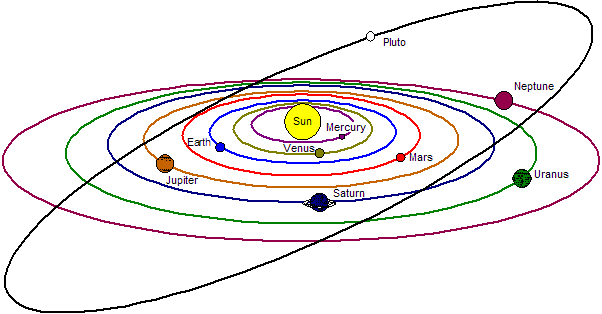HOW TO TELL PLUTO FROM URANUS (title by Adam Saraceno)
BRIAN WRITES... So tell me Jim, what do you think of the International Astronomical Union's recent definition of a planet?
For those who may have missed it, our solar system has just lost a planet. There is a new definition what constitutes a planet and Pluto doesn’t make the grade. Pluto is now in the new category of “dwarf planet”. That new designation also includes the large asteroid belt object Ceres and the recently discovered Kuiper belt object “2003 UB313” or “Xena” the 10th planet.

The questions boil down to this... If a body in space revolves around a star, is it a planet? If it is big enough to be spherical will that make it a planet? What about if it is only one of many objects in the same general orbit? Is Pluto a planet with a moon or a double planet? They just keep finding more and more stuff and it is all different. It just gets confusing as to where to draw the lines.
My opinion on this is they finally got it right. In 1930, when Clyde Tombaugh discovered Pluto, astronomers were looking for another planet that would explain some discrepancies in the known planets motions. When he found Pluto, he had no way to tell what it’s size or proper motion was. If they knew what they know now, it would have never been classified as a planet to begin with. It is very different, in many ways, than the eight “classic” planets. It also never did explain those discrepancies.

The debate is really much ado about nothing. What’s the difference between a hill and a mountain; a pond and a lake; a creek and a river? As astronomers made more and more discoveries, the whole planet thing was bound to get messy and we probably haven’t heard the last of this debate.
It’s not all that different from the debate about when the new millennium started. 2000? 2001? Who cares as long as we can party like it’s 1999!


5 Comments:
Thanks for giving us some sound reasoning in these troubled times. I was about to classify my derriere as Pluto. After reading this I now know it should be designated as the other planet mentioned in the title of this blog post.
I suspect the widespread consternation is because learning the planets was one of first pieces of rote memorization. Somehow our brains are unwilling to accept that earlier programming as wrong.
But I have another question for you. If you put a coin on the track of a small commuter train, what will happen to it? I ask this because when certain persons have done this very act nothing is left but a dark smear and a faint image (not indentation) of the coin in the polished steel of the track. It appears that it is effectively vanishes, but surely a small commuter train isn't sufficient to do that, is it?
What if we originated on Jupiter? Wouldn’t Earth be a “dwarf planet”?
I do not consider a strict definition required: We give names to any space object of even minimal interest (even if they do look like a number.)
Why not just use “Planet” as the highest classification for objects circling stars to differentiate from other objects and either
1. never use it for trivial objects or
2. only use it for the technical name (ala the Latin names for plants) or
3. add suffixes to differentiate size: -oid for tiny, -ic for gigantic, -ike for earth-like size.
and i can call my derriere "jordan"
I've just heard that the IAU is adding new classifications, as follows:
Planet
Dwarf-Planet
Trans-Neptunian Object
Potato-Shaped Solar Orbiter
Floating Space-Boulder
Pretty Good Sized Chunk o' Space Rock
Smaller Than a Bread Basket
Interplanetary Pet Rock
Wee Sized Little Guy
Just a Bit of Sand Really
Orbitting Glitter
Post a Comment
<< Home